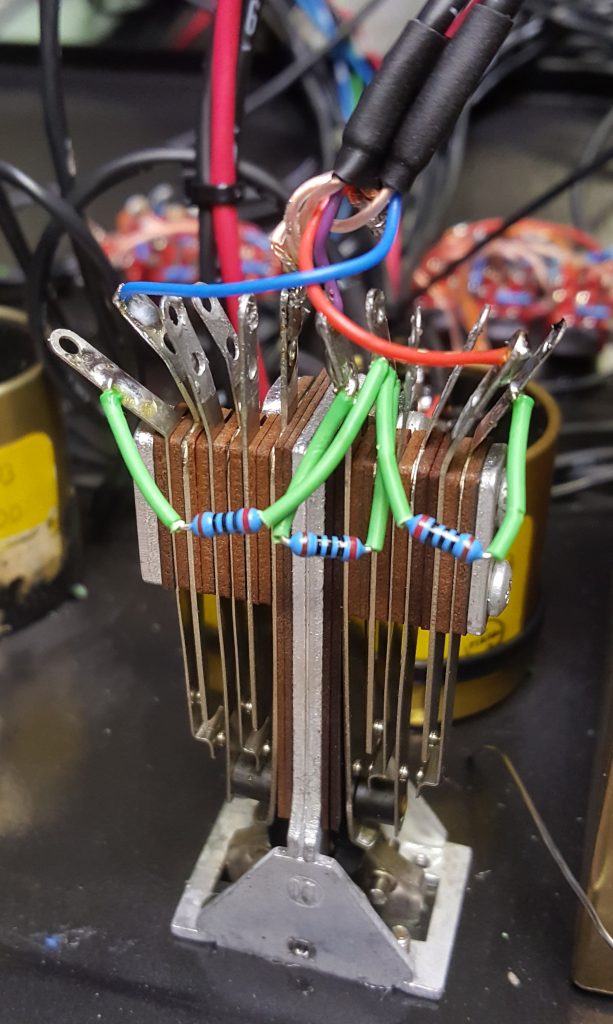Universal Audio Tube Mixer Project

I’ve built several pieces of audio gear over the years, but this one is special to me. In the late ’80s I had an audio repair shop in Sheffield, Alabama (just like now). I’d been doing repair work for Rick Hall at Fame Studios in Muscle Shoals. Rick had just upgraded studio A with the Neve 8232 still in use today. The echo chamber was full of retired “junk” of all varieties. There was lots of stuff I could use at my shop, so I made a trade with Rick for some chairs, old test gear, junk boxes full of wire scraps, parts etc.

In the midst of random bits I find two Universal Audio 100D tube preamps. I had no idea what they were, and there wasn’t really an internet to search then. They were just some old tube modules retired like the rest of the stuff. They lived in a box for the next 30 years with other “junk” from that trade with Rick. By this time, I understood these were some of the maiden microphone ampifiers hand-built by Universal Audio in 1958/59 and that they surely had some funky electrons flowing through them in that era.

Enter Matt Ross-Spang. Check him out if you’re not familiar. I’d known Matt a while by then, and the tale of the Fame UA-100D channels stuck in his mind. Matt was headquartered at the historic Sam Phillips Recording Service in Memphis and knew of the same type modules stored within. Matt has the upmost respect for the history of these types of artifacts, making him the perfect curator for equipment such as this. He worked a deal for a pair of 100Ds from the Phillips studio and we got to work on a four channel mixer with two channels from Fame Studios in Muscle Shoals, and two from Sam Phillips Recording Service in Memphis. That still sort of blows me away.

We rounded up four Universal Audio 508 envelopmental equalizers, two of which randomly presented themselves for purchase to Matt during a recording session. These things are rare! Matt has a lot of positive karmic equity, I’m sure of it.

We settled on a split layout, with two channel pairs to infer their separate histories. Space forced the VU meters into an overbridge with switching between channels 1-3 and 2-4. Interestingly, I had three bad original UA Weston VUs from another “junk” buy. I also had several nice VUs from MCI gear. I swapped the Weston trim and faceplates onto the MCI VUs (with a little trimming) and they look great. The VUs are driven by balanced buffers and lit by LED.
We wanted as much flexibility as we could squeeze from the modules. The feature set wound up being:

- Phase/Phantom
- 10dB pad, 15dB pad, 25dB pad (both on)
- 50/150 ohm input selection
- Original UA 508 Equalizers in the feedback circuit
- L-C-R panned passive mix bus
- Channels switchable between “Stand Alone” mode or mix bus.
- Langevin 600 ohm attenuators

Matt sourced four period correct leaf lever switches for bus assignment. They went through the ultrasonic bath and work great. We decided to leave the output of the passive stereo mix bus unamplified to allow the user to choose any flavor of amplifer with 35-40dB of gain for makeup. The bus is coupled to the outside world through UTC A22 transformers. A flip of a switch gives you an independent channel on its own output jack.

The power supplies were built into a Hewlett-Packard VTVM shell retaining its original dB meter. A tube rectified and regulated section delivers 335 volts DC to the modules. When the high voltage is correct, the dB meter reads “0dB”. Filament voltage is DC biased at about 80 volts. A separate switching supply provides 24 volts to the meter bridge while an additional 48 volt supply is used for phantom power. The wires for the different voltages were enclosed in a grounded braided shield, then a nylon braid was threaded over everything for the outer cover. The console end of the cable splits to a large connector for high voltage/filament and a smaller one for the lower DC voltages.

We wanted to conjure the feel of the early UA consoles with their strange green paint. I guess you love it or hate it… we love it! The first use of the unit was at Fame Studios recording Spooner Oldham‘s Wurlitzer electric piano through the Fame UA 100D channels for the upcoming Aretha Franklin movie, “Respect“. How cool is that?
“Little Greenie” now resides in Memphis and keeps busy guiding melodic electrons along their way.